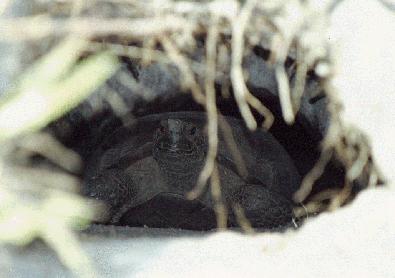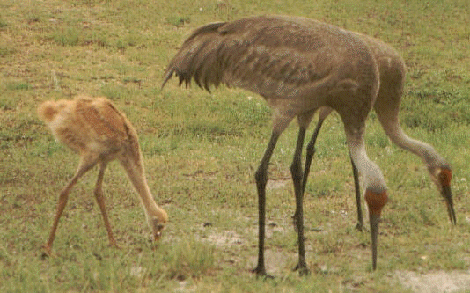 They would have startled large numbers of wading birds quietly and
intently fishing along the shores.
They would have startled large numbers of wading birds quietly and
intently fishing along the shores.Rockledge, A Look Back
Below is an excerpt from
the
Rockledge Conservation Study, 1991.*
Perhaps the best way to introduce modern day to the wildlife and natural resources in the City of Rockledge is to place them in a historical perspective; to reconstruct a picture of what the City once was in terms of natural resources in order to understand where we have come from, where we stand today and where we might go in the future. The fictitious account which follows takes you back 200 years to and early exploratory trip in the vicinity of what is now the City.
At
first light the early settlers to the vicinity of the City would have approached
by boat from the Indian River Lagoon crossing over shallow, clear waters looking
down on thick, luxuriant seagrass beds. The
explorers would have caught breakfast with ease as the fisheries were superb and
diverse. Perhaps they would have
been observed by a cruising manatee, or juvenile sea turtle, or even a bald
eagle passing overhead. Rockledge
would have been a good place to land as there was no impassable mangrove of salt
marsh fringe. The explorers would
have drawn up their boat on the coquina banks overshadowed by a dense, dark
canopy of live oak branches sweeping down towards the water.  They would have startled large numbers of wading birds quietly and
intently fishing along the shores.
They would have startled large numbers of wading birds quietly and
intently fishing along the shores.
As
they would have worked their way up the slope passing huge old oaks and red bays
and the occasional gumbo limbo their passage would have been through almost
impenetrable thickets of saw palmettos and then more open areas where the canopy
over head was particularly dense. If
they were lucky they would have heard a noisy band of Carolina parakeets,
brilliant green flashes, tumbling and chattering over the tops of the forest
trees. As the explorers emerged up
out of the forest their eyes would have been dazzled by the bright light and
heat of the sun bouncing off the white sugar sand and scrub oaks making up a
long ridge running north and south. Perhaps,
way south in the distance they could have spotted the smoldering remnants of a
fierce scrub fire. Suddenly, at eye
level in the scrub, the explorers would have been approached by a family of
friendly, chattering scrub jays who would have escorted them on their slow
passage up towards the light canopy of the sand pines along the top of the
ridge.  On their way up they would
have seen several undeterred marching gopher tortoises and perhaps a large
indigo snake slipping quietly into the undergrowth.
On their way up they would
have seen several undeterred marching gopher tortoises and perhaps a large
indigo snake slipping quietly into the undergrowth.
At
the top of the slope under the sand pines swaying in the light resinous noonday
breeze, the dry twigs and open vegetation would have cracked underfoot; ever an
invitation for a sudden lightening fire. Maybe
from the vantage point of an old sand pine the explorers could have glimpsed out
over the vast coastal plain to the west dominated by pinelands and interspersed
with a multitude of small wet grassy prairies.
Heading out west over this landscape they would have battles through
incredible growths of saw palmettos and skirted around ancient long leaf pines,
scarred by many fires and dripping with resin.
Woodpeckers would have abounded-maybe, a glimpse of a family of
red-cockaded woodpeckers chipping away at and old pine.
Crossing the wet, grassy swards full of flowers and orchids, would have
provided intermittent relief for the explorers.
Signs of wildlife would have been everywhere: bear droppings in an open
clearing, a single almost comical bobcat sitting pert on its haunches at the
edge of a small wetland; the clatter of quail, wild turkey, and sandhill cranes  on an open forest edge; and, if they were lucky, the
indelible pawprint of a Florida panther in a muddy track on the edge of a larger
marsh.
on an open forest edge; and, if they were lucky, the
indelible pawprint of a Florida panther in a muddy track on the edge of a larger
marsh.
Towards late afternoon the explorers would have found themselves again in the deep shade of a hammock-but this one would have required them to wade waist deep through muck soils and skirt around the bases of innumerable old cabbage palms and fallen logs. The mosquitoes would have been unbearable by this stage; perhaps the sound of an ivory billed woodpecker in the deep recesses of the hardwood forest.
By dusk, the explorers eventually would have looked out west over the almost infinite expanses of the marshes of the St. Johns River. As the sun set pink and red on their day the sky would have been completely filled with vast flocks of wading birds – ibis, woodstorks, herons and egrets – returning to their night roost.
The City of Rockledge would have awaited another day.
Clearly the City, just like the rest of Florida, is no longer what it used to be in terms of natural resources. Much of its wildlife disappeared during the first great wave of destruction. Wetland bird species are down to an estimated 10% of their original numbers. Only 5% of the old long leaf pine forest remains. Several species have already gone extinct of disappeared from the City of Rockledge. However much that remains is of great value and well worth preserving even though it is a mere snapshot of the previous wealth of wildlife.